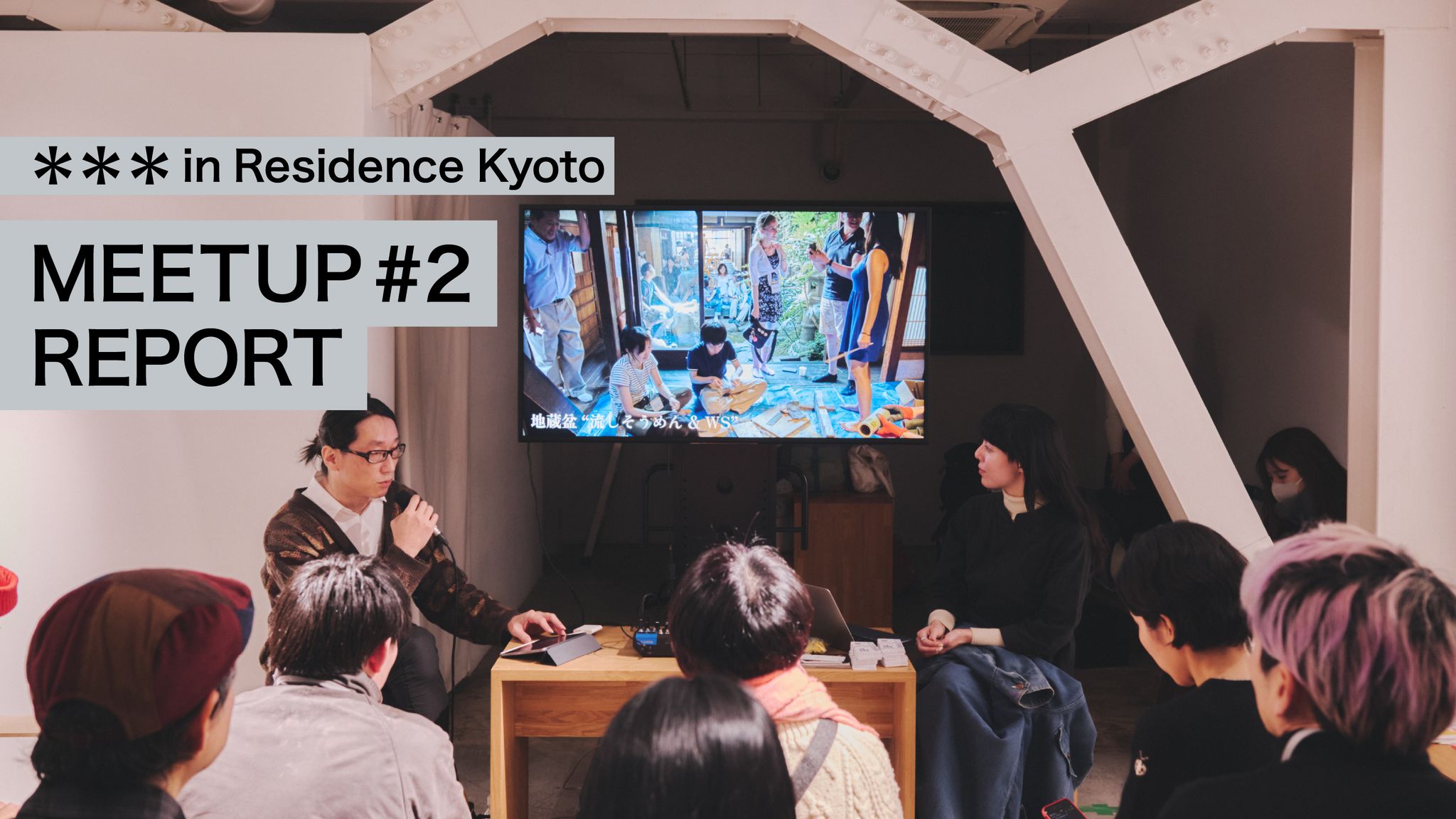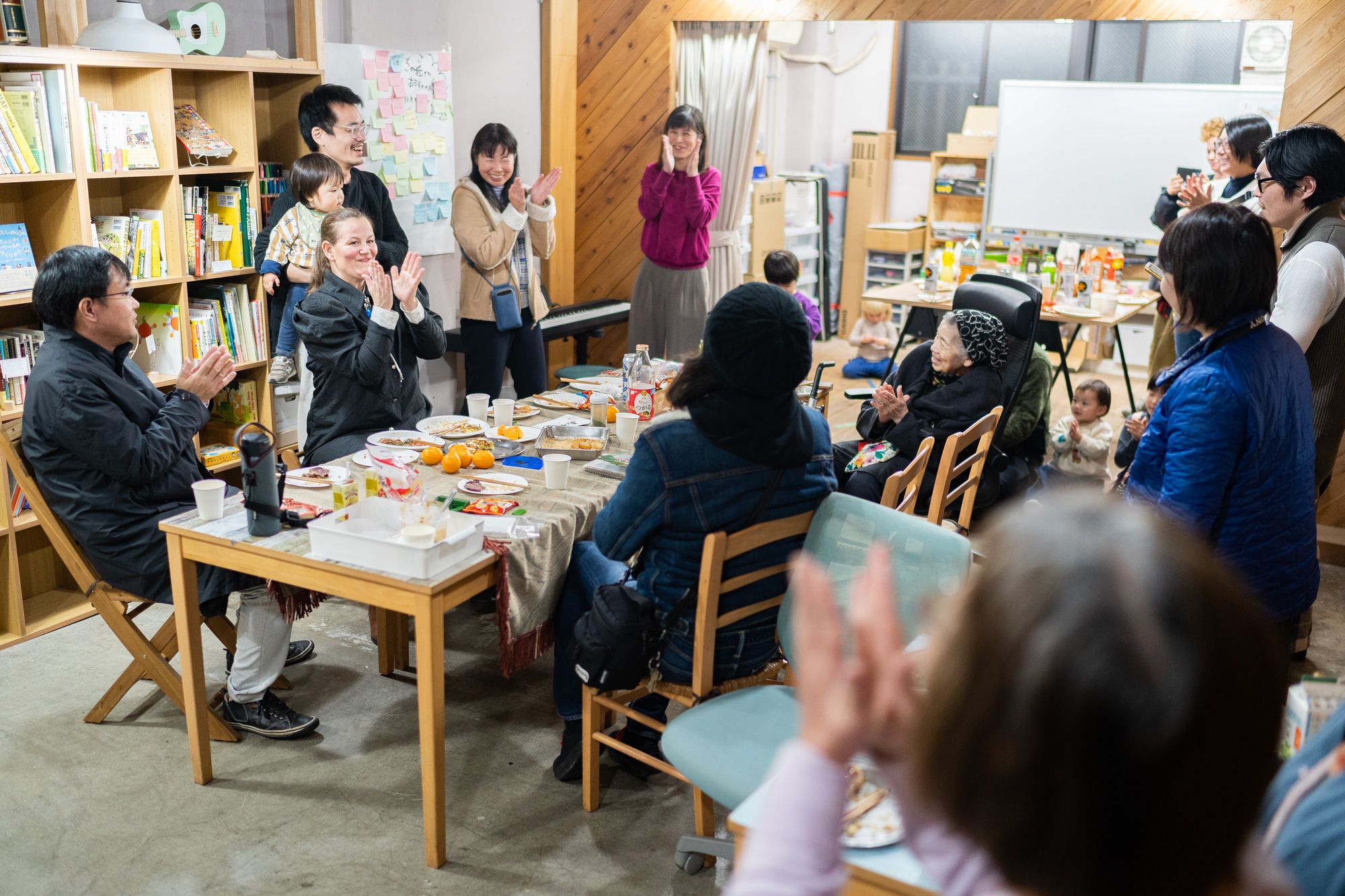<MEETUP#2 REPORT>「*** In Residence」

京都市でスタートする、レジデンスプログラム「*** In Residence Kyoto(アスタリスク・イン・レジデンス 京都)」。世界文化自由都市・京都を世界の多彩な才能と交流できる街にするために、これはアートだけに留まらず建築や文学、工芸や料理、そしてスタートアップなどビジネス領域も含めて多様なフィールドのクリエイターを受け入れる試みです。
初回のMEETUPイベントを経て、2024年12月19日にMEETUPイベントvol.2が、上京区の堀川団地内にあるNo.317 ANEWAL Gallery で開催されました。今回は実践編と題して、相談会と交流会という2部制。レジデンス事業を既に行っている方や興味がある方などを対象に、お悩み相談や具体的なアドバイスなど、意見交換がなされるオープンな場となりました。
取材・文:小倉ちあき
撮影:三輪恵大
**(Asterisk) in Residence Kyoto is an upcoming residency program in Kyoto. The goal of this program is to make Kyoto, a city open to the free exchange of world cultures, a place where people can interact with diverse talent from around the world. In order to do so, *** in Residence Kyoto seeks to invite creators from a wide range of disciplines including art, architecture, literature, craft, cuisine, and even business fields such as startups.
Following the first MEETUP event, the second one was held on December 19, 2024 at No.317 ANEWAL Gallery located within Horikawa Danchi in the Kamigyo ward of Kyoto. With a focus on practicality, this meetup was divided into two parts: a consultation session, and a networking event. The meetup served as an open forum for those already engaged in or interested in the residency business to exchange opinions, discuss their concerns, and offer specific advice.
Interview and text by Chiaki Ogura
Photo by Keita Miwa
京都の街で、よりクリエイティブなステイを! Making stays in Kyoto more creative
司会進行は、本プロジェクトの事務局メンバーであり初回のMEETUPイベントにも登壇した、for Citiesの杉田真理子さんが務めました。自身もアーティストインレジデンス(以降、レジデンス)の実践者であり、日々創造的なまちづくりに取り組んでいます。前段として、「*** In Residence Kyoto」の背景を紹介するところから会はスタート。コロナ禍を経て再び日本全体で海外から訪れる方が増えています。ツーリズムを考える中で、中長期の滞在を通してコラボレーションを行ったり、よりミーニングフルな滞在を促進するためのプロジェクトが「*** In Residence Kyoto」です。
The moderator was Mariko Sugita (Bridge Studio / for Cities), a member of the project's directorial team and a speaker at the first MEETUP event. Sugita is an artist-in-residence manager, and is involved in creative urban development on a daily basis. The meeting started by introducing the background of *** in Residence Kyoto. Since the global pandemic, the number of overseas visitors has begun increasing throughout Japan. Against a backdrop of tourism considerations, *** in Residence Kyoto is designed to promote collaboration and offer more freedom of discovery through mid- to long-term stays.
これまでの観光旅行や滞在には、消費的なものが多かったのではないか?という問いかけが、杉田さんからありました。買う・見る・食べるという、観光地で行われがちな消費行動だけではなく、作品制作やリサーチを通した滞在を行うことで、よりそのまちそのものに息づく文化にリアルに触れることができるのではないでしょうか。そしてそれはまた、滞在者だけでなく、滞在者を受け入れる人たちにとっても学びがあり、地域や文化にも還元できる「置き土産」になり得るのではないでしょうか。滞在者とそれを受け入れる人たちの双方にとって、価値がある創造的な滞在を増やしていくためのプラットホーム。それが、「*** In Residence Kyoto」の目指すところなのです。
Sugita asked attendees if they had noticed a pattern of consumption during their own past travels. Her point was that visiting creatives can more truly experience the culture that lives and breathes throughout the city by creating artwork and conducting research rather than simply participating in consumer practices of buying, seeing, and eating. This approach has the opportunity to be a learning experience for both the resident creatives and for the people who host them, a kind of souvenir that can be returned to the local community and culture. *** in Residence seeks to increase the number of creative stays and create value for both visitor and host.
これは京都市の掲げる、「京都の若者が世界の多彩な才能と交流する仕組みづくり」に関する取り組みです。これまで主にアートの文脈で行われてきたレジデンスの仕組み自体も、広げていける可能性があります。高まるニーズを背景に、発想を転換することでアート文脈だけではない多彩なクリエイティブ層を受け入れていけるはずです。
This residency program is an initiative the city of Kyoto has put forth to create a system for Kyoto's youth to interact with diverse talent from around the world. The residency system itself, which until now has been conducted mainly in the context of art, has the potential to expand. With the growing demand for residency programs, Sugita argues that a shift in thinking will enable Kyoto to accommodate a diverse range of creativity that is not limited to artistic contexts alone.
その一方で、滞在者に対してどのような滞在やネットワーキングがよりクリエイティブなステイとなりえるか、は新たな課題でもあります。受け入れる人たちがかかえるこの「宿題」を解くためには、レジデンスにおける知見の共有のための仲間作りとノウハウの蓄積を進めていく必要があります。やり方の知恵を共有し、共に考えていこうとする場のひとつが、今回のミートアップなのです。
On the other hand, this approach brings new challenges, such as considerations regarding residency formats and networking approaches that will lead to more creative stays for the residents. Addressing these issues requires building a community of friends and accumulating shared knowledge. This MEETUP served as an opportunity to do both.
地域コミュニティとレジデンスをオープンに繋げる Openly connecting local communities and residencies
事例紹介として、特定非営利活動法人 ANEWAL Gallery 飯髙 克昌さんが登壇。飯髙さんは「外に出るギャラリー」をコンセプトに現代美術をメインにさまざまなプロジェクトを行っています。現代美術のレクチャースペースやクラフテリア(シェア工作室)、レジデンススペース、ギャラリー、堀川団地の公団の空室と、西陣エリアの5ヶ所に拠点を構えています。アーティストインレジデンスも2014年から実践。アーティストは前述の各拠点を滞在、制作、発表の場として、また地域との交流プラットフォームとして「ANEWAL Gallery」を活用しています。
Katsumasa Iitaka of ANEWAL Gallery, a non-profit organization, took the stage to introduce a case study. Iitaka is engaged in a variety of contemporary art projects based on the concept of a gallery’s external engagement. He has five locations in the Nishijin area, including a lecture space for contemporary art, a shared workshop, a residence space, a gallery, and a vacant room in the Horikawa Danchi public housing complex. In addition, he has been managing artist-in-residence programs since 2014. Artists use the aforementioned locations as places to stay, create, and present their work, utilizing the ANEWAL Gallery as a platform for exchange with the local community.
1つ目の事例として、フランスの建築家カップルを招聘した事例が挙げられました。滞在中には、京町家のリサーチを行ったり、専門家によるレクチャーを実施したり、木造建築の継ぎ手の工房を訪れたりしたそうです。滞在の往復を何度か繰り返し、3年という期間を経たのち、最終的に制作発表展覧会を開催。京町家の居間の畳を取り外して、設置した水盤に水を張るというインスタレーションで、インパクトのあるものでした。
The first case study Iitaka presented was a French architect couple. During their stay, the pair conducted research into traditional Kyoto townhouses, organized lectures by specialists, and visited a wood joinery workshop. After three years of repeated visits, the couple finally held an exhibition to present the results of their work. The installation, which involved removing the tatami mats from the living room of a traditional Kyoto townhouse and filling a basin with water, had a strong impact on the exhibition attendees.

制作発表展覧会の様子 ©︎ NPO ANEWAL Gallery
Research project exhibition
ノルウェーから訪れた、アーティストの事例も出されました。お子さんを連れて訪れた彼女の滞在目的は、妖怪についてのリサーチ。制作発表では、自らも妖怪に変装するなどユニークなものとなりました。2ヶ月という滞在期間中に、堀川団地に住まう子どもたちとすっかり仲良くなっており、滞在最終日に開かれたフェアウェルパーティでは、仲良くなった家族たちと共に時間を過ごしていたそう。ここまでの風景が自分たちの目指すレジデンスの形だと、飯髙さんは説明します。
Iitaka also presented a case study of a visiting artist from Norway who came to Japan with her child in order to research yokai (Japanese monsters). During her two-month stay, the artist made friends with the children living in Horikawa Danchi, and spent time with them at the farewell party held on the last day of her stay. Iitaka explained that his organization aims to create residency opportunities that produce these kinds of outcomes.

フェアウェルパーティの様子 ©︎ NPO ANEWAL Gallery
Farewell party
「滞在と制作、そして発表の3つが、アーティストインレジデンスを行う上で、必要なインフラであることは間違いありません。ただそれにとどまらず、地域文化や地域コミュニティ、地元のアーティストらと交流し、場を共有することで、地域そのものに思考をもたらしていく…そういうアーティストインレジデンスでありたいです」と続けます。
Iitaka stated, “There is no doubt that three elements are necessary for an artist-in-residence program: residency, production, and presentation. Still, we want to go beyond that. We want to be an artist-in-residence program that brings new ideas and considerations to the area by interacting and sharing space with local culture, the local community, and local artists.”
文化芸術の促進とまちづくりが、飯髙さんが活動する上での両輪にあります。その一つに長年地域で続けられている上京朝カフェがあり、現在はANEWAL Galleryを含む地元有志で運営されています。これが地域コミュニティの大きな土壌となっていると言います。他にも地域の祭り「堀川まつり」のサポートなども行っており、アートやレジデンスには直接関係ないものの、これら地域での活動があるからこそ、アーティストが滞在した時に、リアルな地域の様子を伝えることができ、また逆にレジデンスの意義を地域に還元できるのだと飯髙さんは話します。
The promotion of culture and the arts, and community development are two of the key components of Iitaka’s activities. One of these projects is the Kamigyo Morning Cafe, which has been running in the community for many years and is now operated by local volunteers, including ANEWAL Gallery. The cafe has become a major source of community in the area. Iitaka also supports the local Horikawa Festival. Although not directly related to art or the residency program, these local activities provide a conduit connecting visiting artists to local businesses and people while simultaneously conveying the significance of the residency to the local community.
飯髙さんの運営する各拠点を起点に、近隣の寺や企業、飲食店などとネットワークが築かれているので、アーティストが滞在した際に、近隣住民や地元クリエイターたちとの交流も生まれやすい環境になっています。ハード(場所)とソフト(人)という2つのレイヤーを主にして、双方向で地域交流を促すこと…人が動くと繋がっていく…、オープンなコミュニティの必要性に気付かされます。
Thanks to Iitaka’s network of operational projects and established contacts with nearby temples, businesses, and restaurants, visiting artists have an easy time interacting with neighborhood residents and local creators when they stay in the area. The two main layers of hardware (place) and software (people) are used to promote bi-directional local exchange. When people are active, they connect, which serves to remind us of the need for an open community.
初期準備は?収益は?ディスカッションでは、リアルな相談が。Practical advice: What goes into building a residency? How much revenue is needed?
アーティストインレジデンスの実態がつかめてきたところで、相談会に突入しました。パネルセッションとして、引き続き、杉田さんと飯髙さんを迎えて、参加者を巻き込みながらのざっくばらんなQ&A相談会が繰り広げられました。
Once the realities of the artist-in-residence program had been conveyed, Mariko Sugita and Katsumasa Itaka held a panel discussion and a frank Q&A session for the attendees.
「海外アーティストが場所を見つける方法は?」「発信はどうやって?」「収益はどのくらい?」「宿泊事業の空き日に展開するには?」など、運営にまつわる具体的な質問が次々と挙げられました。集客に関しては、日本のアーティスト・イン・レジデンスの総合サイトであるAIR Jなどの専用サイトからアーティストが自主的に見つけてくる場合もあれば、アーティスト同士のツテや口コミで直接連絡がくることも多いそう。SNSのDMからメッセージが届くことも増えているといいます。運営までの準備についても、不安が多いようです。未然にトラブルを防ぐコツとしては、近隣への挨拶や情報共有は丁寧に行うことや、滞在者への条件提示は必ず事前に行っておくことなどのアドバイスも出ました。またランニングコストは低く始められる場所で始めることもおすすめポイントだと言います。
Questions related to program operation and other specific inquiries were posed to the panel: “How do international artists find residencies?” “What’s the best way to advertise?” “What are the profit margins?” “Is there a way to take advantage of hotel vacancies and use them for residencies?” Sugita and Iitaka explained that some artists find out about residency programs through websites such as AIR-J, a comprehensive website for artist-in-residence programs in Japan, while others learn about residencies via word of mouth or contacts with other artists and approach the managers directly. Many residencies also receive an increasing number of messages through social media. There seemed to be concern among the attendees about the preparatory steps necessary to begin operations. Some tips for preventing problems included greeting neighbors and sharing information carefully, and always presenting the conditions of your stay to the visitors in advance. The panel also recommended starting operations in a place with low running costs.
杉田さんも過去を振り返って、「滞在者の約90%は、出身国の行政から助成金をもらって訪れています。滞在者を受け入れる他のやり方としては、“物々交換制度”でしょうか。例えばカメラマンなどであれば、滞在する際に、お願いする映像を撮影することを条件に、滞在費を半額にするというような形で対応する場合もあります。アーティストインレジデンスは利益をもたらすことだけを目的にしなくてもいいと思います。交流を通して得られる相乗効果の方に期待しています」と話した。それを受けて飯髙さんも、「レジデンスはもっと気軽に始めて大丈夫。家の空き部屋が一つあるから、知り合いのアーティストに使ってもらうとか、それでも十分、アーティストインレジデンスだと言えると思う」とコメント。一同が納得し、安堵の空気が流れました。
Looking at past examples, Sugita said, “About 90% of visiting artists come to Japan using subsidies from the governments of their home countries. Another way of accepting visitors is through a barter system. For example, a photographer may be offered half the cost of a residency on the condition that they volunteer their time to shoot specific footage for the program. Artist-in-residence programs do not have to concern themselves exclusively with profits. We’re interested in the synergistic effects that come about through the exchange.” In response, Katsumasa Iidaka added, “Residencies can be started casually. If you have a spare room in your house and ask an artist you know to use it, I think you can still call it an artist-in-residence.” There was a palpable sense of relief in the room as the attendees nodded in agreement.
レジデンスにまつわる具体的な法律についての議論も交わされました。レジデンスは、あくまでも「宿泊」ではなく「滞在」であるため、滞在の目的をきちんと明示しておくなどの対応が必要になるそう。その他にもこれからのアイデアや理想のイメージなども会場から上がりました。
杉田さんは、プロジェクトの今後の展開として「レジデンスに取り組む仲間作りと知見の共有を促していきたいです。どのエリアでどのくらいの規模の施設が、どの程度の資金でレジデンス事業を運営できているのかのデータベースや、弁護士や法律専門家を招聘して不動産周りの知識の勉強会を設けたりなど、互いに情報をシェアできる環境があればいいと思っています。クリエイティブ人材と地域の知的交流の結果が蓄積されることで、京都をより一層クリエイティビティが生まれやすい場にしていきたい」とコメントし、相談会を締め括りました。
Specific laws related to residencies were also discussed. Residencies are not classified as “accommodation,” but rather as “stays,” making it necessary to clearly state the purpose of the stay, among other things. The attendees also put forth ideas for future projects and ideal program conditions and outcomes.
As for the future development of the *** in Residence project, Sugita brought the consultation session to a close with the following comments: “I would like to encourage people to make friends and share knowledge about their residency programs. We’d like to create an environment where we can share information with each other, for example, through a database that records what size facilities in what areas are operating residency projects and with what level of funding, or by inviting lawyers and legal experts to hold study sessions on real estate-related knowledge. We would like to further encourage creativity throughout Kyoto by accumulating the results of intellectual exchange between creative personnel and the local community.”
その後場所を移動し、交流会の場へ。初対面同士の挨拶や紹介、情報共有が積極的に行われていました。1部では聞きにくかった、より具体的なお悩みを直接相談している様子も伺えました。物件取得について、アーティストに提供できるもの、滞在制作のために必要なこと、展覧会の企画方法など、話が現実的になればなるほど、相談事はこれからいくらでも出てくるでしょう。
MEETUPイベントは、第3回まで予定されています。1月からのモデル事業開始を前に次第に現実味を帯びてくる中、京都に滞在し、歴史ある文化遺産と美しい自然景観に触れ、新しい感覚で何かを生み出し表現すること。そんな人たちが京都に集まるなんて、考えるだけでワクワクしますね。「*** In Residence Kyoto」に参加する、新たなクリエイターとそれを受け入れる人たちと共に、京都という文化都市をより魅力的な交流の場に育てていきたいです。
After the session had concluded, the participants moved to a different space to socialize and network. The first-time participants greeted each other and shared their experiences. It was clear they were discussing more specific concerns that they had been unable to ask in the previous session. As the discussions became more practical, there were many more questions to be addressed, such as how to acquire property, what types of services to offer the visiting creatives, what materials to provide for the creation of work during the residency, and how to plan an exhibition.
The third MEETUP event is scheduled to be held in the near future. With the model project set to begin in January, the idea of staying in Kyoto, experiencing its historical cultural heritage and beautiful natural scenery, and creating and expressing something with a new sensibility is becoming more realistic by the day. Just the thought of such a diverse group of people gathering in Kyoto is enough to make one breathless with excitement. Alongside the new *** in Residence Kyoto participants, and the people who will host them, the city continues its tireless efforts to become a more compelling place for the free exchange of world cultures.
◯次回ミートアップ予定
日程:2025年1月28日(火) 18:30-20:30
会場:ゲーテ・インスティトゥート|ヴィラ鴨川(Goethe-Institut Villa Kamogawa)
◯Next scheduled meetup
Date: Tuesday, January 28, 2025, 18:30-20:30
Venue: Goethe-Institut Villa Kamogawa
Reservation form here (Apply between: January 15 (Tue.) and January 27 (Mon.), noon)